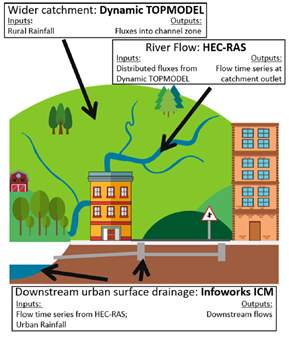The impact of Natural Flood Management on the performance of surface drainage systems: a case study in the Calder Valley
By C.Ferguson and R.A.Fenner
Journal of Hydrology 590 (2020) 125354
This study investigates how NFM interventions in upstream rural catchments may moderate water levels in downstream watercourses, helping sustain free discharge from drainage outfalls, thereby improving the performance of urban surface drainage systems. A coupled modelling methodology is applied to the upper Calder Valley and the surface drainage in an area of the downstream town of Todmorden. The rural response and subsequent NFM interventions are characterised using hydrological (Dynamic TOPMODEL) and hydraulic (HEC-RAS) models. Several downstream surface drainage systems are then incorporated using an Infoworks ICM model to examine their response to changes in outfall inundation.
The results suggest that catchment-scale tree planting and in-channel woody debris create modest benefits for downstream surface drainage systems. Under frequent storm events (e.g. a 1 in 10 year storm), the inundation of low-lying outfalls is completely removed. As storm severity increases (and surface flooding becomes an issue), impact from upstream NFM attenuation on outfall inundation durations diminishes significantly. However, the slight delay in rural response allows more water to escape surface systems, increasing the effective capacity of networks and reducing surface flooding.
This paper is available online at: https://doi.org/10.1016/j.jhydrol.2020.125354

